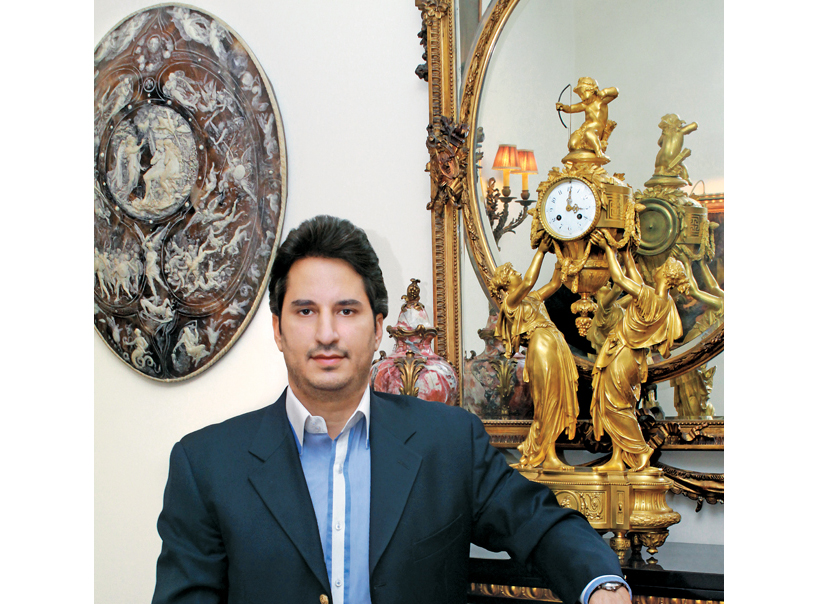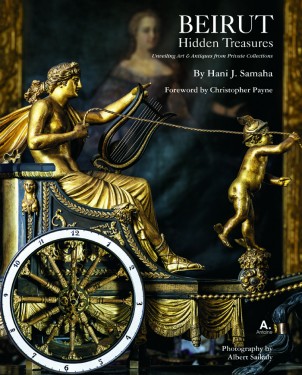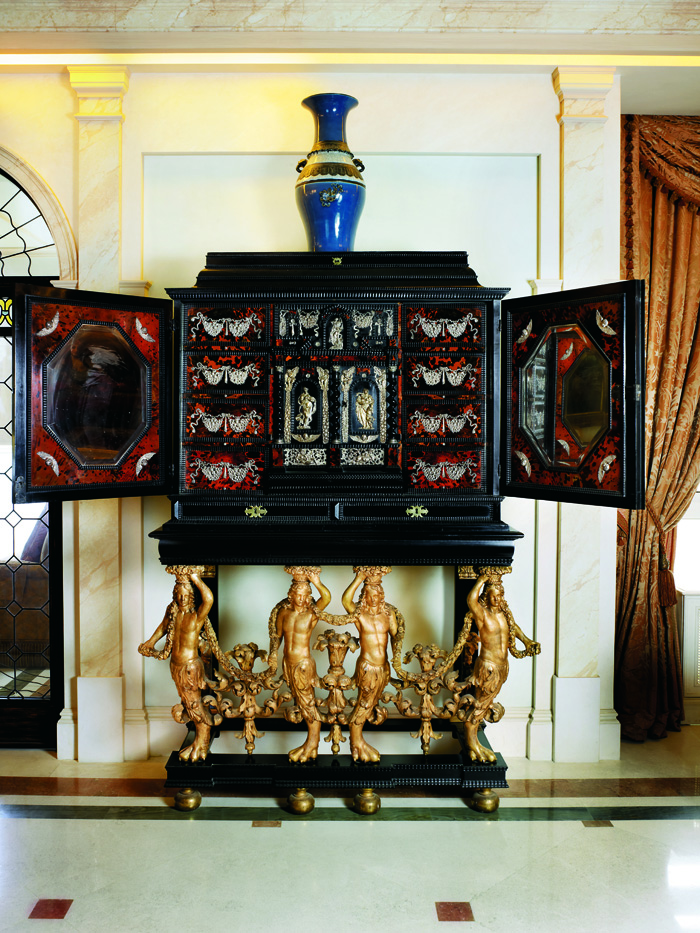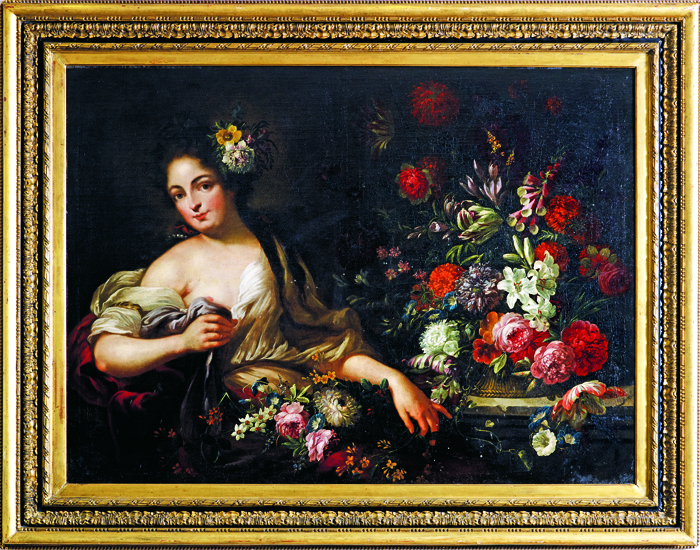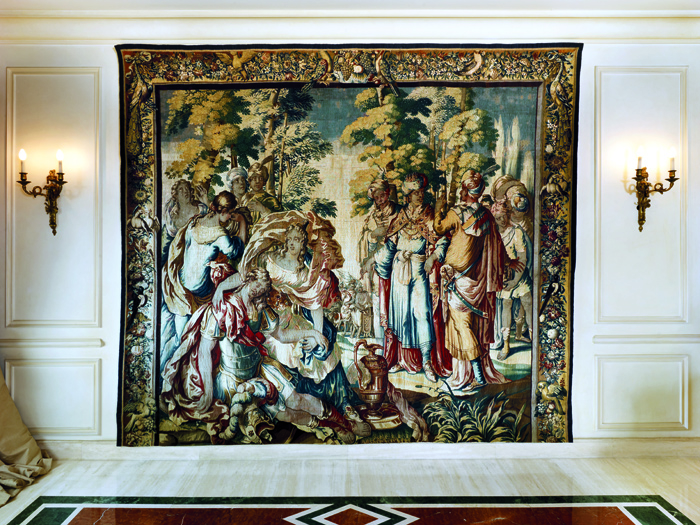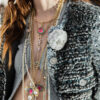Prestige issue N°248, March 2014
Hani J. Samaha
unveils the hidden treasures of Beirut
in his 7th book
Splendors and houses of the capital, as well as the beauty of the palaces and Decorative Arts in Lebanon, thoroughly explored and revealed in his six previous books, the publisher, author and artist Hani J. Samaha selected in his seventh illustrated wonder ” Beirut hidden Treasures Unveiling Art & Antiques from Private Collections ” hidden treasures of Beirut. Not in archaeological sites, but inside these beautiful Beiruti homes he loves to visit, to bring to light unique pieces, trinkets, furniture and other masterpieces and objects worthy of great museums. Over two hundred seventy pages illustrating four hundred pieces, Hani J. Samaha tells Prestige about his latest jewel, carefully prefaced by Christopher Payne, director of Sotheby’s.
© Beirut Hidden Treasures/Photos: Albert Saikaly
Hani J. Samaha, publisher, author and refined artist.
© Beirut Hidden Treasures/Photos: Albert Saikaly
On the cover of the book a very rare and monumental Empire period clock symbolizing Apollon cart in gilded and patinated bronze.
You have a reputation for being a passionate of beauty and antiques … How did you reach this knowledge? From my family and my educational background. I grew up in a family of antique dealers and fine art connoisseurs, where I was attracted by each piece. An addiction to beautiful pieces that I hold from my youth, and a connection that led me first to discover this little world of beauty, and then the vast world of antiques. As I was studying at Depaul University of Chicago, I took the opportunity to go to New York to attend large auctions and meet leading international experts. I even skipped classes to be present at these events. Culture comes with knowledge, with reading, traveling and contact with experts. I would like to note that 1500 books on the subject garnish my private library.
You have edited a seventh book. Can you introduce it to us? The seventh book presents something different, something new that I consider the best of all my works. Forty-seven chapters illustrate forty-seven private collections of Lebanese homes, from tapestry to silverware, clocks and furniture of the seventeenth, eighteenth and nineteenth centuries, in the French, English and oriental styles. In each category, we chose the best of the best pieces worthy of the greatest museums in the world. Two hundred and seventy pages are illustrated and commented in a professional manner with detailed descriptions: century, origin, signature, cabinetmaker to prevent this work from resembling in any way to an auction catalog, the book has been designed in a way that you can see the detail of the art object on a page, and its location inside a room, on the other. Thus, the attention to detail is reserved for connoisseurs, and its location within the home to decorators.
In «Beirut Hidden Treasures», you reveal unique art pieces displayed inside Lebanese houses. How did you get this idea? This is because I edited six bestselling books on decorating, I wanted this time, to speak to the brain, reflection, and not only the eyes. We had to go into the most specific detail, scanning homes and collections. This is a private effort. Having this key that allows me to go confidently in the residence, made all my reputation. The houses themselves were already difficult to detect, even more to discover. What would it be for art objects? The idea of an international book on antique pieces in Lebanon crossed my head, and I decided to report in the manner of an investigator. Thus «Beirut Hidden Treasures» emerged after two years of research and investigation. This is the first and only book published on antiques in Lebanon, from private collections. I would also point out that the majority of Lebanese houses in the book have been photographed for the first time.
© Beirut Hidden Treasures/Photos: Albert Saikaly
A magnificent French – Flemish XVIIth century cabinet in ebony wood and turtle shell, resting on 4 gilded statues.
In which context the preface of the book was written by the director of Sotheby’s, Christopher Payne?Christopher Payne is the director of Sotheby’s, and one of the world’s most important experts. The first contact I had with him goes back to fifteen years. He had published numerous books on European furniture, I had bought all of them while dreaming to write myself one day a book he would preface. When I sent him the pictures of the pieces, he was surprised to see these rare pieces. But the expert was not satisfied with the pictures, he also claimed the texts, to be sure about my information. And again, he was very satisfied and agreed to affix his precious seal (Seal of Approval) . From my side, I was very pleased to have achieved my dream of seeing a personality of such level, preface my work.
Names of international renowned experts are also in your book … Indeed, experts Cynthia Harris, Head of Silver & Decorative Arts Department at Sotheby’s, and Nicole de-Pazzis Chevalier expert in tapestry, have provided their valuable assistance, each one inher field. Cynthia Harris unveiled rare pieces, some from very good royal provenance. And Nicole de-Pazzis Chevalier detailed all information about tapestry: theme, date…
You have presented these treasures in an intelligent and specific way. Can youexplain to us…? In fact, I have in no way presented the works in a boring or routine manner, as in a catalog. First, we see the house then the art object in detail. Thus, the lover of beautiful homes will see the house, and the lover of art will only see the beautiful piece. None of them will get bored. I would like to mention in this context also the name of the great cabinetmakers that we can see in the book, like François Linke, Henry Dasson , Paul Sormani , Millet, Stephen Smith and Robert Garrard .
What is the theme of the cover? why did you choose this piece specifically?We took time to choose the piece that would illustrate the cover. I hesitated between five objects. I wanted to put a clock, because the wheel is symbolic to me. Finally, I opted for a very rare and monumental Empire period piece, a clock symbolizing the cart of Apollo in bronze, of exceptional quality in two tones: gilded and patinated. I made my choice on this piece because it doesn’t look like a work for auction, but rather be exposed in a beautiful interior.
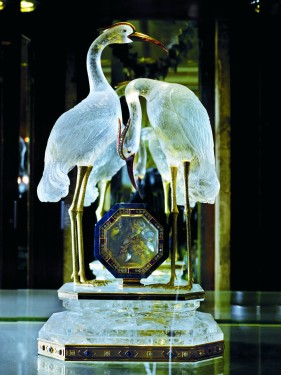
«Young woman with a vase of flowers» painting dated end of XVII century, signed Gaspar-Pieter VerBruggen Le Jeune.
© Beirut Hidden Treasures/Photos: Albert Saikaly
Do you think that you have revealed all the hidden treasures of Beirut?Aren’t thereother treasures not revealed yet? There are a lot of treasures that have not yet been revealed. For the simple reason that a job of this magnitude requires many volumes. On one hand, some pieces are scattered and on the other hand, some owners refuse to disclose their treasures. This significant number of masterpieces is due to the attachment of the Lebanese to antiques and valuable pieces.
How do you feel when describing anart object? I believe that the book itself is a piece of luxury furniture. I feel a great joy and happiness because It’s a kind of revivalto the artist who created the piece. I must say that I have collected a lot of information and learned a lot about the pieces mentioned in the book.
To whom you would like to dedicate the book? This book is dedicated to all antique dealers, collectors, homeowners, for interior architects and Fine Arts students.
Do you have new ideas for books in this kind? Ideas are always present. When I stop having ideas, I am no longer young, I have aged.
© Beirut Hidden Treasures/Photos: Albert Saikaly
«The death of Abradate» Aubusson Tapestry Royal Manufacture end of XVII century.
What would you add? First I want to thank the whole team who worked closely for the publication of this book. I also thank all the owners of the houses visited, these great families who had the kindness and courtesy to open up their doors for me to take photographs. Without this effort by each of them, the book would not have been released in this way. Finally I would like to send a message to the readers, encouraging them to read more, read better, in order to increase their culture. Interview by Mireille BridiBouabjian


